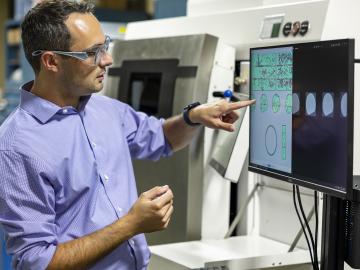Filter News
Area of Research
- (-) Advanced Manufacturing (34)
- (-) Computer Science (19)
- (-) Materials for Computing (36)
- Biological Systems (18)
- Biology and Environment (177)
- Biology and Soft Matter (5)
- Building Technologies (12)
- Chemical and Engineering Materials (4)
- Chemistry and Physics at Interfaces (11)
- Clean Energy (522)
- Climate and Environmental Systems (14)
- Computational Biology (6)
- Computational Chemistry (5)
- Computational Engineering (5)
- Data (1)
- Earth Sciences (1)
- Electricity and Smart Grid (3)
- Energy Frontier Research Centers (14)
- Energy Sciences (5)
- Fossil Energy (3)
- Fuel Cycle Science and Technology (3)
- Functional Materials for Energy (16)
- Fusion and Fission (54)
- Fusion Energy (17)
- Geographic Information Science and Technology (3)
- Isotope Development and Production (3)
- Isotopes (35)
- Materials (433)
- Materials Characterization (2)
- Materials Synthesis from Atoms to Systems (13)
- Materials Under Extremes (12)
- Mathematics (1)
- National Security (79)
- Neutron Data Analysis and Visualization (4)
- Neutron Science (190)
- Nuclear Science and Technology (74)
- Nuclear Systems Modeling, Simulation and Validation (3)
- Nuclear Systems Technology (1)
- Quantum Condensed Matter (4)
- Quantum information Science (9)
- Reactor Technology (1)
- Renewable Energy (4)
- Sensors and Controls (5)
- Supercomputing (311)
- Transportation Systems (11)
News Type
News Topics
- 3-D Printing/Advanced Manufacturing (26)
- Advanced Reactors (1)
- Artificial Intelligence (7)
- Big Data (4)
- Bioenergy (2)
- Biology (1)
- Biomedical (2)
- Buildings (1)
- Chemical Sciences (4)
- Climate Change (1)
- Composites (4)
- Computer Science (23)
- Coronavirus (3)
- Cybersecurity (2)
- Decarbonization (1)
- Energy Storage (6)
- Environment (2)
- Exascale Computing (1)
- Fusion (1)
- Grid (2)
- High-Performance Computing (2)
- Isotopes (1)
- Machine Learning (5)
- Materials (16)
- Materials Science (21)
- Microscopy (4)
- Nanotechnology (7)
- National Security (1)
- Neutron Science (7)
- Nuclear Energy (2)
- Polymers (6)
- Quantum Computing (1)
- Quantum Science (6)
- Security (1)
- Simulation (1)
- Space Exploration (2)
- Summit (2)
- Sustainable Energy (12)
- Transformational Challenge Reactor (1)
- Transportation (5)
Media Contacts

Scientists at ORNL have developed 3D-printed collimator techniques that can be used to custom design collimators that better filter out noise during different types of neutron scattering experiments

ORNL is home to the world's fastest exascale supercomputer, Frontier, which was built in part to facilitate energy-efficient and scalable AI-based algorithms and simulations.

Researchers at the Department of Energy’s Oak Ridge National Laboratory have improved flaw detection to increase confidence in metal parts that are 3D-printed using laser powder bed fusion.

A research team from the Department of Energy’s Oak Ridge and Lawrence Livermore national laboratories won the first Best Open-Source Contribution Award for its paper at the 37th IEEE International Parallel and Distributed Processing Symposium.

Oak Ridge National Laboratory’s Innovation Crossroads program welcomes six new science and technology innovators from across the United States to the sixth cohort.

Tackling the climate crisis and achieving an equitable clean energy future are among the biggest challenges of our time.

Oak Ridge National Laboratory researchers collaborated with Iowa State University and RJ Lee Group to demonstrate a safe and effective antiviral coating for N95 masks. The coating destroys the COVID-19-causing coronavirus and could enable reuse of masks made from various fabrics.

A force within the supercomputing community, Jack Dongarra developed software packages that became standard in the industry, allowing high-performance computers to become increasingly more powerful in recent decades.

A study by researchers at the ORNL takes a fresh look at what could become the first step toward a new generation of solar batteries.

Oak Ridge National Laboratory researchers recently used large-scale additive manufacturing with metal to produce a full-strength steel component for a wind turbine, proving the technique as a viable alternative to




